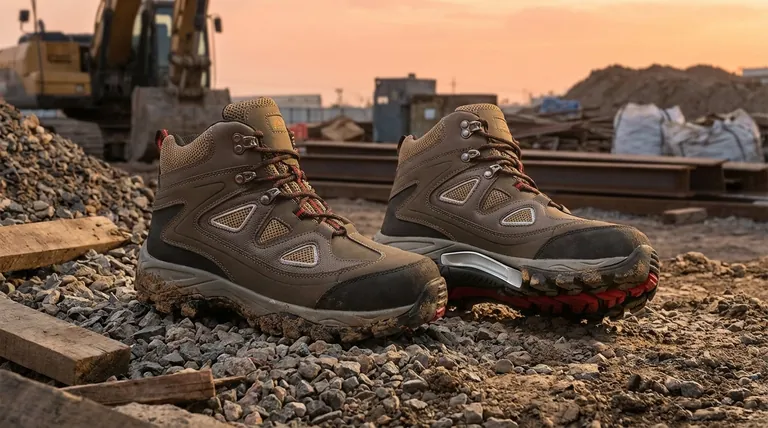At its core, the shank is the structural backbone of a safety boot. It is a semi-rigid piece of material inserted into the midsole, located under the arch of your foot, that serves the critical functions of providing support and controlling how the boot flexes. Without it, a boot would bend in the middle, leading to instability and significant foot fatigue.
The shank is not merely a feature; it is the fundamental component that gives a safety boot its structural integrity. It ensures the boot bends where your foot bends, protecting the arch from strain and providing a stable platform on any surface.

Understanding the Shank's Role
A well-designed safety boot works as a system, and the shank is the linchpin that holds it together. It is typically a narrow strip made of materials like steel, fiberglass, or composite plastics.
The Hidden Support Structure
The shank is positioned between the insole you feel and the outsole that touches the ground. Its primary job is to bridge the gap between the heel and the ball of the foot, creating a rigid, supportive platform.
Controlling the Flex Point
The most critical function of the shank is to ensure the boot bends at the correct anatomical point—the ball of the foot. It prevents the boot from collapsing and flexing in the arch, which would place unnatural stress on the bones and ligaments in your foot.
Maintaining Stability on Unstable Ground
By reinforcing the midsole, the shank provides torsional rigidity. This prevents the boot from twisting when you walk on uneven surfaces like gravel, rocks, or debris, significantly reducing the risk of ankle sprains.
The Consequences of a Poor or Missing Shank
The absence of a proper shank is immediately noticeable in a boot's performance and can have long-term consequences for foot health, especially in demanding work environments.
Increased Foot Fatigue
Without a shank, the muscles in your feet have to work much harder to maintain your arch and provide stability. This leads directly to soreness and fatigue over the course of a workday.
Heightened Risk of Injury
A boot that flexes in the arch can contribute to painful conditions like plantar fasciitis and metatarsal stress. The lack of proper support allows the foot to over-pronate or strain unnaturally with every step.
Instability on Ladders and Pegs
For anyone who climbs ladders or stands on narrow rungs, a shank is essential. It distributes your body weight across the entire sole of the boot, preventing the intense pressure point that would otherwise focus directly on your arch.
How to Apply This to Your Needs
Understanding the shank allows you to select footwear that is appropriate for your specific work environment and activity level.
- If your primary focus is working on flat, hard surfaces: A shank ensures consistent arch support, which is critical for preventing fatigue over long shifts.
- If your primary focus is working on uneven terrain: Torsional stability from a strong shank is non-negotiable for preventing ankle twists and maintaining balance.
- If your primary focus involves climbing or standing on rungs: A rigid shank is a crucial safety feature that protects your arch from impact and strain.
Choosing the right safety boot means investing in the underlying structure that will protect you day after day.
Summary Table:
| Function | Benefit | Key Takeaway |
|---|---|---|
| Controls Flex Point | Boot bends at the ball of the foot, not the arch. | Prevents arch strain and conditions like plantar fasciitis. |
| Provides Torsional Rigidity | Resists twisting on uneven ground. | Reduces risk of ankle sprains and improves balance. |
| Distributes Weight | Spreads pressure evenly across the sole. | Essential for climbing ladders; prevents foot fatigue. |
Protect your workforce with the right foundation.
As a large-scale manufacturer, 3515 produces a comprehensive range of safety footwear for distributors, brand owners, and bulk clients. Our expertise ensures every boot is built with a structurally sound shank, providing the critical support and stability needed for demanding work environments.
Contact our team today to discuss your safety footwear needs and discover how our production capabilities can deliver durable, protective boots for your market.
Visual Guide

Related Products
- Safety Footwear Wholesale Manufacturer for Custom OEM/ODM Production
- Premium Flame-Retardant Waterproof Safety Boots and Shoes
- Premium KPU Injection Athletic Style Safety Shoes
- Wholesale Leather Safety Boots with Customizable Protective Toe
- Wholesale Durable Breathable Safety Boots Custom OEM Manufacturer
People Also Ask
- What are the cultural perspectives on wearing shoes in the house? A Guide to Home Etiquette & Hygiene
- What cultural and environmental considerations are tied to wearing shoes indoors? Balance Hygiene, Tradition, and Foot Health
- How long can you wear safety boots? The Lifespan is Determined by Wear, Not Time
- Is it normal to wear shoes in the house? A Guide to Hygiene, Comfort & Culture
- What are the differences between steel toe, composite toe, and alloy toe Wellington boots? Choose the Right Safety Toe for Your Job



















